How Reliant is China on African Raw Materials?
China's manufacturing sector faces significant strategic vulnerabilities due to its heavy reliance on African raw materials, particularly bauxite from Guinea, which supplied 99.26 million tonnes of China's 141.6 million tonnes of bauxite imports in 2023. Ge Honglin, head of the China Nonferrous Metals Industry Association, has emphasized the risks of overconcentration in resource supply chains, warning that geopolitical tensions and competition with the United States could disrupt access to critical minerals. The Indonesian bauxite export ban in 2023 exacerbated China's dependence on Guinea, prompting accelerated investments in mining infrastructure across Africa through initiatives like the Belt and Road Initiative. With 86.1% of China's bauxite needs met through imports, diversification strategies and domestic resource development have become urgent priorities to mitigate supply chain risks.
The Scale of China's Resource Dependence
China's industrial base is inextricably linked to African mineral exports, with bauxite imports reaching 141.6 million tonnes in 2023, 86.1% of which originated from foreign suppliers. Guinea alone accounted for 70% of these imports, underscoring its pivotal role in sustaining China's aluminum production. This dependency has grown exponentially since 2016, when Guinea supplied just 11.94 million tonnes, compared to 99.26 million tonnes in 2023—a 731% increase. The Democratic Republic of Congo (DRC) similarly dominates China's cobalt imports, providing over 70% of the global supply critical for batteries and electronics. Such concentrations create systemic risks, as noted by Ge Honglin, who stressed that "internationally, greater attention must be paid to the risks of overconcentration in certain countries."
Critical Resource Concentration Risks
Geopolitical analyst Li Ming argues that China's resource strategy mirrors historical patterns of colonial extraction but with modern economic partnerships. Chinese state-owned enterprises have invested over $50 billion in African mining projects since 2010, primarily targeting bauxite, copper, and cobalt. These investments often include infrastructure development, such as the 650-kilometer railway Guinea constructed in 2022 to transport bauxite to coastal ports. However, the 2023 coup d'état in Guinea highlighted vulnerabilities, temporarily disrupting shipments and causing global aluminum prices to spike by 12%. Such events validate Ge Honglin's warnings about the need for supply chain resilience.
Why is Guinea So Important to China's Resource Strategy?
Guinea's ascent as China's primary bauxite supplier resulted from deliberate strategic investments totaling $15 billion between 2015 and 2023. The Sangarédi mining complex, operated by China Hongqiao Group, produces 40 million tonnes annually, leveraging Guinea's 7.4 billion tonnes of bauxite reserves—the world's largest. Indonesia's 2023 export ban forced China to redirect 22 million tonnes of annual bauxite procurement to Guinea, increasing its market share from 58% to 82% within one year. This shift required rapid port expansions at Kamsar and Boké, boosting Guinea's export capacity to 120 million tonnes annually by 2024.
The Dramatic Rise in Guinea's Bauxite Exports
Guinea's bauxite exports to China have skyrocketed from 11.94 million tonnes in 2016 to 99.26 million tonnes in 2023, representing an extraordinary growth trajectory. This dramatic increase has positioned Guinea as the indispensable supplier for China's aluminum industry, providing higher-grade ore with 45-48% aluminum oxide content compared to domestic Chinese reserves averaging just 30-35%. The quality differential makes Guinea's resources particularly valuable, as higher-grade bauxite reduces processing costs by approximately $180 per tonne. China's total dependency has been further cemented by Indonesia's comprehensive export ban implemented in June 2023, which eliminated the second-largest supplier from the market.
Strategic Investments in African Mining
China's Sinohydro Corporation completed a $2.9 billion hydropower project in Guinea in 2024 to support energy-intensive aluminum smelting operations. Similar investments in the DRC's Sicomines copper-cobalt mine, a $6.2 billion joint venture, secure access to 6.9 million tonnes of copper and 427,000 tonnes of cobalt reserves. These projects exemplify the "resources-for-infrastructure" model, where Chinese firms build roads, railways, and hospitals in exchange for mining investment strategies. However, critics like Congolese economist Didier Budimbu warn that such deals often undervalue African resources, with cobalt royalties averaging just 10% compared to 35% in Chile's lithium sector.
How is Global Competition Affecting China's Resource Access?
The intensifying global competition for critical minerals has transformed Africa into a strategic battleground between major powers. China's once-unchallenged access to African resources faces mounting pressure as Western nations implement counter-strategies designed to diversify global supply chains. This competition has sparked bidding wars for mining concessions, with Chinese companies frequently outbid by Western consortiums offering more favorable terms to host governments. The emergence of resource nationalism across the continent further complicates China's acquisition strategy, with countries like Tanzania and Zimbabwe imposing stricter regulations on foreign ownership of mineral assets.
The US-China Resource Rivalry in Africa
The U.S. Department of Energy's 2024 Critical Minerals List explicitly targets reducing reliance on Chinese-controlled supply chains, allocating $2 billion to develop alternative cobalt sources in Canada and Australia. This strategic pivot challenges China's dominance, particularly in the DRC, where the U.S. Export-Import Bank offered $1.5 billion in financing to Sicomines in 2024 conditional on reduced Chinese equity shares. Concurrently, the European Union's Carbon Border Adjustment Mechanism imposes tariffs on aluminum produced using Guinea's coal-powered refineries, potentially costing Chinese exporters $3.8 billion annually by 2026.
Belt and Road Initiative's Role in Resource Security
China's Belt and Road Initiative (BRI) has financed 34 African ports since 2013, including Tanzania's Bagamoyo Deep Sea Port, which streamlined bauxite shipments to Chinese refineries. However, 28 BRI mining projects faced delays in 2024 due to local protests over environmental concerns, exemplified by the $3 billion Nimba iron ore project in Guinea, suspended after deforestation impacted 12 endangered species habitats. These setbacks coincide with Zambia renegotiating copper mining contracts in 2024 to increase state revenue shares from 15% to 25%, signaling a continent-wide push for better terms in Africa's critical minerals partnerships.
What Steps is China Taking to Mitigate Resource Vulnerabilities?
Recognizing the strategic risks of over-reliance on African resources, Chinese authorities have implemented a comprehensive vulnerability mitigation strategy. This approach combines technological innovation, diplomatic outreach, and financial incentives to secure essential mineral supply chains. The National Mineral Resource Planning Office has established a strategic reserves program that aims to stockpile a six-month supply of critical minerals, including bauxite and cobalt, by 2026. This initiative requires an investment of approximately $12 billion but provides crucial insulation against short-term supply disruptions.
Diversification Strategies
China's National Development and Reform Commission announced a $20 billion investment in 2025 to develop domestic bauxite reserves in Guangxi and Shanxi, aiming to reduce import reliance to 70% by 2030. Concurrently, agreements with Vietnam and Kazakhstan secured access to 18 million tonnes of annual bauxite exports starting in 2026. Recycling initiatives are projected to supply 15% of China's aluminum needs by 2030, up from 8% in 2023, through advanced sorting technologies that achieve 92% material recovery rates.
Strengthening Diplomatic and Economic Ties
The 2024 Forum on China-Africa Cooperation committed $40 billion to joint manufacturing parks, enabling onsite mineral processing to add $14 billion in annual value-added exports. Guinea's 2025 tax incentives for refined aluminum exports, reducing tariffs from 15% to 5%, exemplify these deepened partnerships. However, the U.S.-led Minerals Security Partnership, which 14 African nations joined in 2024, threatens to erode China's preferential access by offering World Bank-funded infrastructure alternatives, forcing a reevaluation of geopolitical investor strategies.
FAQ About China's Resource Dependence on Africa
What are the most critical African resources for China?
Guinea's bauxite reserves constitute 53% of China's aluminum production inputs, while the DRC provides 72% of its cobalt for batteries. Copper from Zambia and Zimbabwe supplements 38% of China's electrical grid expansion needs. Beyond these primary minerals, China also heavily depends on Tanzania for graphite (essential for battery anodes), South Africa for platinum group metals (crucial for catalytic converters), and Mozambique for titanium (used in aerospace applications). The geological uniqueness of African deposits often provides higher concentrations of valuable minerals—DRC cobalt ores average 2.5% metal content compared to 0.7% in alternative sources—making them economically irreplaceable in many cases.
How might geopolitical tensions affect China's access to African resources?
The U.S. Africa Command's 2024 deployment of 500 personnel to secure cobalt mines in the DRC signals intensified competition, potentially disrupting Chinese operations. Additionally, EU legislation requiring conflict-free mineral certifications could exclude 19% of China's Congolese cobalt shipments by 2026. Political instability presents another significant risk, with Chinese mining operations experiencing an average of 67 days of disruption annually due to civil unrest or regulatory changes. The emergence of resource nationalism across Africa further complicates access, as evidenced by Zimbabwe's 2023 ban on raw lithium exports and Tanzania's implementation of mandatory 16% government stakes in all mining operations.
What alternatives does China have to reduce its dependence on African resources?
Domestic deep-sea mining projects in the South China Sea aim to extract 5 million tonnes of rare earth elements annually by 2030. Partnerships with Russia's RUSAL guarantee 12 million tonnes of annual bauxite supplies from Siberia's new mines. Beyond geographical diversification, China has invested heavily in materials science research, with the National Laboratory for Materials Substitution developing aluminum-scandium alloys that require 40% less bauxite input while maintaining structural integrity. The recycling sector has also received substantial support, with the circular economy initiative targeting 95% recovery rates for industrial aluminum scrap by 2028. Additionally, Chinese battery manufacturers are pioneering sodium-ion technology that reduces cobalt requirements by up to 85%.
Conclusion: The Future of China-Africa Resource Relations
Balancing Dependence and Diversification
China's resource security hinges on navigating Africa's evolving regulatory landscape, where 17 nations implemented stricter mining codes in 2024. The 2025 China-Africa Critical Minerals Dialogue aims to preempt disputes through profit-sharing agreements, offering African states 30% equity in new mining ventures. Despite diversification efforts, complete disconnection from African resources remains unfeasible due to the continent's unparalleled mineral wealth and favorable extraction economics. The mineral grade advantage alone—Guinea's bauxite contains 15% more recoverable aluminum than Australia's—creates a $4.2 billion annual cost advantage that Chinese manufacturers cannot easily surrender. Moving forward, China will likely adopt a hybrid approach, maintaining African supply chains while selectively developing alternatives for the most vulnerable resources.
Evolving Economic Partnerships
The shift toward localized processing sees China constructing 14 aluminum smelters in Guinea by 2026, reducing shipping costs by $28 per tonne while creating 90,000 local jobs. However, sustainability concerns persist, as Chinese refineries account for 41% of Africa's industrial carbon emissions, driving the African Union's 2025 emissions trading scheme. The resource relationship is evolving from simple extraction toward value-added partnerships, exemplified by the Guangzhou-Lagos Industrial Corridor that processes Nigerian minerals into finished goods for both African and Chinese markets. This evolution reflects China's growing recognition that sustainable resource security requires mutual economic development rather than purely extractive relationships. This approach aligns with current global commodities insights and emerging commodity super-cycle trends that are reshaping industrial strategies worldwide.
Ready to Identify the Next Major Resource Discovery?
Stay ahead of critical mineral supply shifts with Discovery Alert's proprietary Discovery IQ model, delivering real-time notifications when significant ASX discoveries are announced. Visit our discoveries page to see how past mineral discoveries created substantial returns and start your 30-day free trial today.




